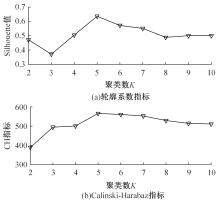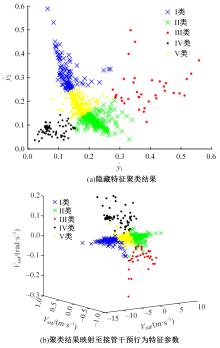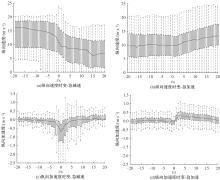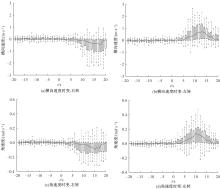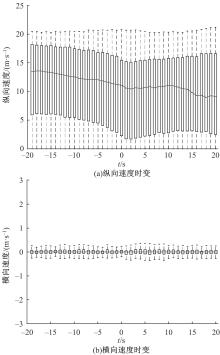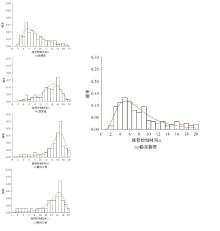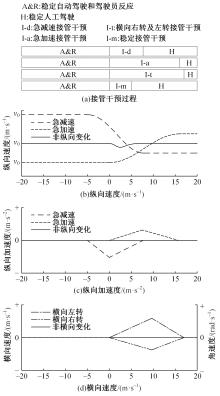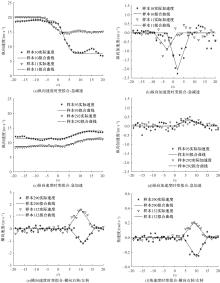Journal of Jilin University(Engineering and Technology Edition) ›› 2024, Vol. 54 ›› Issue (3): 727-740.doi: 10.13229/j.cnki.jdxbgxb.20220553
Analysis of drivers′ intervention behavior in autonomous truck road testing
Hui-zhao TU1( ),Wan-jin WANG1,Peng QIAO2,Jing-qiu GUO1(
),Wan-jin WANG1,Peng QIAO2,Jing-qiu GUO1( ),Chang LU1,Hai-fei WU3
),Chang LU1,Hai-fei WU3
- 1.Key Laboratory of Road and Traffic Engineering,Ministry of Education,Tongji University,Shanghai 201804,China
2.Shanghai Lingang Science and Technology Innovation City Economic Development Co. ,Ltd. ,Shanghai 201306,China
3.SICVIC (Shanghai) Co. ,Ltd. ,Shanghai 201306,China
CLC Number:
- U491
| 1 | Sinha A, Chand S, Vu V, et al. Crash and disengagement data of autonomous vehicles on public roads in California[J]. Scientific Data, 2021, 8(1): 1-10. |
| 2 | 中关村智通智能交通产业联盟, 北京智能车联产业创新中心. 北京市自动驾驶车辆道路测试报告(2021年)[R]. 北京: 北京市自动驾驶测试管理联席工作小组, 2022. |
| China Mobility Alliance, Beijing Innovation Center for Mobility Intelligent. Beijing autonomous driving vehicle road test report(2021)[R]. Beijing: Beijing Autonomous Driving Test Management Joint Working Group, 2022. | |
| 3 | 上海市交通委员会. 上海市智能网联汽车发展报告(2021年)[R]. 上海: 上海市交通委员会, 2022. |
| Shanghai Municipal Transportation Commission. Shanghai intelligent connected vehicle development report(2021)[R]. Shanghai: Shanghai Municipal Transportation Commission, 2022. | |
| 4 | 陆键, 王可, 蒋愚明. 基于车辆行驶轨迹的道路不良驾驶行为实时辨识方法[J]. 交通运输工程学报, 2020, 20(6): 227-235. |
| Lu Jian, Wang Ke, Jiang Yu-ming. Real-time identification method of abnormal road driving behavior based on vehicle driving trajectory[J]. Journal of Traffic and Transportation Engineering,2020, 20(6): 227-235. | |
| 5 | 张姝玮, 郭忠印, 杨轸, 等. 驾驶行为多重分形特征在驾驶疲劳检测中的应用[J]. 吉林大学学报: 工学版, 2021, 51(2): 557-564. |
| Zhang Shu-wei, Guo Zhong-yin, Yang Zhen, et al. Application of multi⁃fractal features of driving performance in driver fatigue detection[J]. Journal of Jilin University (Engineering and Technology Edition), 2021, 51(2): 557-564. | |
| 6 | 姚荣涵, 徐文韬, 郭伟伟. 基于因子长短期记忆的驾驶人接管行为及意图识别[J]. 吉林大学学报: 工学版, 2023, 53(3): 758-771. |
| Yao Rong-han, Xu Wen-tao, Guo Wei-wei. Drivers' takeover behavior and intention recognition based on factor and long short-term memory[J]. Journal of Jilin University (Engineering and Technology Edition), 2023, 53(3): 758-771. | |
| 7 | Zeeb K, Buchner A, Schrauf M. Is take-over time all that matters? The impact of visual-cognitive load on driver take-over quality after conditionally automated driving[J]. Accident Analysis & Prevention, 2016, 92(7): 230-239. |
| 8 | Rangesh A, Deo N, Greer R, et al. Autonomous vehicles that alert humans to take-over controls: modeling with real-world data[C]∥2021 IEEE International Intelligent Transportation Systems Conference (ITSC), Indianapolis, USA, 2021: 231-236. |
| 9 | Du N, Zhou F, Pulver E M, et al. Predicting driver takeover performance in conditionally automated driving[J]. Accident Analysis & Prevention, 2020, 148: No. 105748. |
| 10 | Guo S, Wu K, Zhang G. Application of PCA-K-means++ combination model to construction of light vehicle driving conditions in intelligent traffic[J]. Journal of Measurements in Engineering, 2020, 8(3): 107-121. |
| 11 | 林庆峰, 王兆杰, 鲁光泉. L3级自动驾驶汽车的接管安全性评价模型[J]. 汽车工程, 2019, 41(11): 1258-1264. |
| Lin Qing-feng, Wang Zhao-jie, Lu Guang-quan. Takeover safety evaluation model for level 3 automated vehicles[J]. Automotive Engineering, 2019, 41(11): 1258-1264. | |
| 12 | 鲁光泉, 陈发城, 李鹏辉, 等. 驾驶人跟车风险接受水平对其接管绩效的影响[J]. 汽车工程, 2021, 43(6): 808-814. |
| Lu Guang-quan, Chen Fa-cheng, Li Peng-hui, et al. Effect of drivers'acceptance level of car-following risk on the takeover performance[J]. Automotive Engineering, 2021, 43(6): 808-814. | |
| 13 | 涂辉招, 崔航, 鹿畅, 等. 面向自动驾驶路测驾驶能力评估的避险脱离率模型[J]. 同济大学学报: 自然科学版, 2020, 48(11): 1562-1569. |
| Tu Hui-zhao, Cui Hang, Lu Chang, et al. A risk-avoiding disengagement frequency model for assessing driving ability of autonomous vehicles in road testing[J]. Journal of Tongji University (Natural Science), 2020, 48(11): 1562-1569. | |
| 14 | Wan J, Wu C. The effects of lead time of take-over request and nondriving tasks on taking-over control of automated vehicles[J]. IEEE Transactions on Human-Machine Systems, 2018, 48(6): 582-591. |
| 15 | Lu Z, Happee R, Cabrall C D, et al. Human factors of transitions in automated driving: A general framework and literature survey[J]. Transportation Research Part F: Traffic Psychology and Behaviour, 2016, 43: 183-198. |
| 16 | 姚荣涵, 祁文彦, 郭伟伟. 自动驾驶环境下驾驶人接管行为结构方程模型[J]. 交通运输工程学报, 2021, 21(2): 209-221. |
| Yao Rong-han, Qi Wen-yan, Guo Wei-wei. Structual equation modell of drivers' takeover behaviors in autonomous driving environment[J]. Journal of Traffic and Transportation Engineering, 2021, 21(2): 209-221. | |
| 17 | Kim J, Kim W, Kim H S, et al. A novel study on subjective driver readiness in terms of non-driving related tasks and take-over performance[J]. ICT Express, 2022, 8(1): 91-96. |
| 18 | 郭烈, 胥林立, 秦增科, 等. 自动驾驶接管影响因素分析与研究进展[J]. 交通运输系统工程与信息, 2022, 22(2): 72-90. |
| Guo Lie, Xu Lin-li, Qin Zeng-ke, et al. Analysis and overview of influencing factors on autonomous driving takeover[J]. Journal of Transportation Systems Engineering and Information Technology, 2022, 22(2): 72-90. | |
| 19 | 钮建伟, 张雪梅, 孙一品, 等. 险情中驾驶人接管自动驾驶车辆的驾驶行为研究[J]. 中国公路学报, 2018, 31(6): 272-280. |
| Niu Jian-wei, Zhang Xue-mei, Sun Yi-pin, et al. Analysis of the driving behavior during the takeover of automatic driving vehicles in dangerous traffic situatios[J]. China Journal of Highway and Transport, 2018, 31(6): 272-280. | |
| 20 | Boggs A M, Arvin R, Khattak A J. Exploring the who, what, when, where, and why of automated vehicle disengagements[J]. Accident Analysis & Prevention, 2020, 136: No. 105406. |
| 21 | Favarò F, Eurich S, Nader N. Autonomous vehicles' disengagements: trends, triggers, and regulatory limitations[J]. Accident Analysis & Prevention, 2018, 110: 136-148. |
| 22 | Khattak Z H, Fontaine M D, Smith B L. Exploratory investigation of disengagements and crashes in autonomous vehicles under mixed traffic: an endogenous switching regime framework[J]. IEEE Transactions on Intelligent Transportation Systems, 2020, 22(12): 7485-7495. |
| 23 | de Waard D, van Der Hulst M, Hoedemaeker M, et al. Driver behavior in an emergency situation in the Automated Highway System[J]. Transportation Human Factors, 1999, 1(1): 67-82. |
| 24 | Strand N, Nilsson J, Karlsson I M, et al. Semi-automated versus highly automated driving in critical situations caused by automation failures[J]. Transportation Research Part F: Traffic Psychology and Behaviour, 2014, 27: 218-228. |
| 25 | 甘蜜, 卿三东, 刘晓波, 等. 货车轨迹数据在公路货运系统中应用研究综述[J]. 交通运输系统工程与信息, 2021, 21(5): 91-101. |
| Gan Mi, San-dong Qing, Liu Xiao-bo, et al. Review on application of truck trajectory data in highway freight system[J]. Journal of Transportation Systems Engineering and Information Technology, 2021, 21(5): 91-101. | |
| 26 | Morgan P L, Alford C, Williams C, et al. Manual takeover and handover of a simulated fully autonomous vehicle within urban and extra-urban settings[C]∥International Conference on Applied Human Factors and Ergonomics, Los Angeles, USA, 2017: 760-771. |
| 27 | Walch M, Lange K, Baumann M, et al. Autonomous driving: investigating the feasibility of car-driver handover assistance[C]∥Proceedings of the 7th International Conference on Automotive User Interfaces and Interactive Vehicular Applications, Nottingham, United Kingdom, 2015: 11-18. |
| 28 | 彭博, 张媛媛, 王玉婷, 等. 基于自动编码机-分类器的视频交通状态自动识别[J]. 吉林大学学报: 工学版, 2021, 51(3): 886-892. |
| Peng Bo, Zhang Yuan-yuan, Wang Yu-ting, et al. Automatic traffic state recognition from videos based on auto⁃encoder and classifiers[J]. Journal of Jilin University (Engineering and Technology Edition), 2021, 51(3): 886-892. | |
| 29 | 郭靖, 侯苏. K-means算法最佳聚类数评价指标研究[J]. 软件导刊, 2017, 16(11): 5-8. |
| Guo Jing, Hou Su. Study on index of determining the optimal clustering number of K-means algorithm[J]. Software Guide, 2017, 16(11): 5-8. | |
| 30 | 吴斌, 朱西产, 沈剑平. 基于自然驾驶数据的驾驶员紧急制动行为特征[J]. 同济大学学报: 自然科学版, 2018, 46(11): 1514-1519, 1535. |
| Wu Bin, Zhu Xi-chan, Shen Jian-ping. Driver emergency braking behavior based on naturalistic driving data[J]. Journal of Tongji University (Natural Science), 2018, 46(11): 1514-1519, 1535. | |
| 31 | Markkula G, Benderius O, Wolff K, et al. A review of near-collision driver behavior models[J]. Human Factors The Journal of the Human Factors and Ergonomics Society, 2012, 54(6): 1117-1143. |
| 32 | 王雪松, 杨敏明. 基于自然驾驶数据的变道切入行为分析[J]. 同济大学学报: 自然科学版, 2018, 46(8): 1057-1063. |
| Wang Xue-song, Yang Min-ming. Cut-in behavior analysis based on naturalistic driving data[J]. Journal of Tongji University (natural science), 2018, 46(8): 1057-1063. | |
| 33 | Lv C, Cao D, Zhao Y, et al. Analysis of autopilot disengagements occurring during autonomous vehicle testing[J]. IEEE/CAA Journal of Automatica Sinica, 2017, 5(1): 58-68. |
| 34 | Liu Q, Wang X, Wu X, et al. Crash comparison of autonomous and conventional vehicles using pre-crash scenario typology[J]. Accident Analysis & Prevention, 2021, 159(4): No. 106281. |
| [1] | Xiao-chi MA,Jian LU. Real⁃time crash prediction of elevated expressway based on gene expression programming algorithm [J]. Journal of Jilin University(Engineering and Technology Edition), 2024, 54(3): 719-726. |
| [2] | Feng-feng ZHOU,Yi-chi ZHANG. Unsupervised feature engineering algorithm BioSAE based on sparse autoencoder [J]. Journal of Jilin University(Engineering and Technology Edition), 2022, 52(7): 1645-1656. |
| [3] | Hong-kui XU,Tong-tong JIANG,Xin LI,Bin-xiang JIANG,Yong-lei WANG. LTE uplink interference analysis combined with denoising autoencoder and extreme learning machine [J]. Journal of Jilin University(Engineering and Technology Edition), 2022, 52(1): 195-203. |
| [4] | Gen-bao ZHANG,Hao LI,Yan RAN,Qiu-jin LI. A transfer learning model for bearing fault diagnosis [J]. Journal of Jilin University(Engineering and Technology Edition), 2020, 50(5): 1617-1626. |
| [5] | ZONG Fang, LU Feng-rui, TANG Ming, LYU Jian-yu, WU Ting. Impact of habit and traffic condition on travel route selection [J]. 吉林大学学报(工学版), 2018, 48(4): 1023-1028. |
|
||
